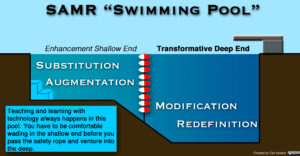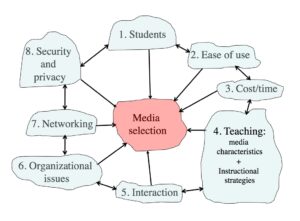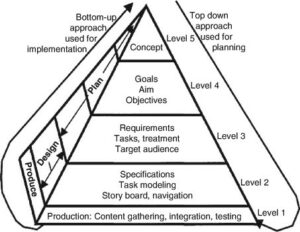
-Firstly, I thought I need to work on dual coding and information processing to make short-term memory moving to long-term memory. Due to that thinking, I was using the split attention principle to make my add-on picture showing at the same time while I am talking about that concept. Then multiple questions represent after the picture because it will help to test whether the audience is engaging or not. Also, it can reflect how well they are learning.
-Secondly, I am using the redundancy principle to make both text/picture and sounds. If they want to look at the picture, the video will pause for the audience to look at it without too much information at once. I am giving the options if the audience prefers to listen and watch the video they can, but if they do not they can mute my mic and just look at a picture that pops up before multiple-choice.
-Thirdly, I am improving my spatial & temporal contiguity principle that the pop-up box has shown both picture and little text demo at the same time on the same page. So, audiences will not need to go back and force. At the same time, I am using the signaling principle to make important words red and let audiences pay close attention. Those small signals will give them the warning to let them know the pop quiz will test on it.
-Overall, I hope I think I make some changes to the original one and make it more interesting because I learn how to make a plan first before I dive into my video. I learn how important to think in the audience’s way and interaction can be beneficial through the learning.

 Multimedia is widely using in people’s daily life, so people are more likely to seek fast and easy technologies such as video, PowerPoint, WordPress, or some other online teaching tools. After I learned the SAMR model, I found that some of the paperwork in school can not just substitute for technologies. For example, I know a lot of teachers are using software or apps to create a test. It saves a lot of time because the computer is doing all the calculations for us. However, if there is one small error that carries out through the whole exam students will be more likely to get a zero. One small error can make a huge difference so the combined real person to go through it or repeat the process might be better just change to technologies. Another point is teachers need to pay more attention to the surface “substitution” part. If students can not get full engagement on the base level, then it is hard to dive into redefinition by using different technology tools.
Multimedia is widely using in people’s daily life, so people are more likely to seek fast and easy technologies such as video, PowerPoint, WordPress, or some other online teaching tools. After I learned the SAMR model, I found that some of the paperwork in school can not just substitute for technologies. For example, I know a lot of teachers are using software or apps to create a test. It saves a lot of time because the computer is doing all the calculations for us. However, if there is one small error that carries out through the whole exam students will be more likely to get a zero. One small error can make a huge difference so the combined real person to go through it or repeat the process might be better just change to technologies. Another point is teachers need to pay more attention to the surface “substitution” part. If students can not get full engagement on the base level, then it is hard to dive into redefinition by using different technology tools. Technologies give people more variety of learning methods. The strength of the SECTION model does explain how people can use select teaching and media tools base on students’ interests. For example, technologies can well support people who are blind or hearing disorder; then they can use either voice record method through online teaching. It is a better way to lower the cost of hiring a professional teacher and decrease stress when people are struggling to learn in a crowded environment. However, depends on the lesson or app that people are creating, it may increase the cost by time and retesting the lessons. Besides, because of the modern fast development of multimedia, it is a lack of privacy that teachers can control. Overall, teachers need to think it is necessary to use section model and multimedia or not, then create the lesson based on the needs.
Technologies give people more variety of learning methods. The strength of the SECTION model does explain how people can use select teaching and media tools base on students’ interests. For example, technologies can well support people who are blind or hearing disorder; then they can use either voice record method through online teaching. It is a better way to lower the cost of hiring a professional teacher and decrease stress when people are struggling to learn in a crowded environment. However, depends on the lesson or app that people are creating, it may increase the cost by time and retesting the lessons. Besides, because of the modern fast development of multimedia, it is a lack of privacy that teachers can control. Overall, teachers need to think it is necessary to use section model and multimedia or not, then create the lesson based on the needs. ns. Nowadays, there are many multimedia lessons had well developed, so people should first make the lesson as fun as possible to catch the audience’s eyes without drying them out through the lesson. Brainstorm and detail plans will make teachers less frustrating if students lose interest or too difficult to follow. The teacher may easily change to another way of teaching this concept because they had fully prepared those outcomes. When people making plans, they should know how to interact with their audience that is related to the Ecological theory. This theory demonstrates how child development can interact with the environment and how environmental factors will influence children’s behavior (Paquette&Ryan, 2009). Therefore, if the teacher had made enough interactions with students, they will not only learn some knowledge through this lesson but also use this knowledge to apply future problems.
ns. Nowadays, there are many multimedia lessons had well developed, so people should first make the lesson as fun as possible to catch the audience’s eyes without drying them out through the lesson. Brainstorm and detail plans will make teachers less frustrating if students lose interest or too difficult to follow. The teacher may easily change to another way of teaching this concept because they had fully prepared those outcomes. When people making plans, they should know how to interact with their audience that is related to the Ecological theory. This theory demonstrates how child development can interact with the environment and how environmental factors will influence children’s behavior (Paquette&Ryan, 2009). Therefore, if the teacher had made enough interactions with students, they will not only learn some knowledge through this lesson but also use this knowledge to apply future problems.
Recent Comments